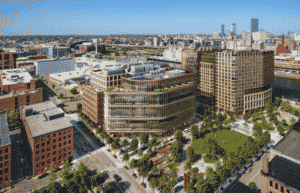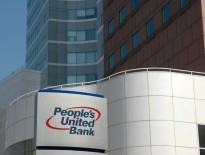State officials have “significant” concerns about a proposed 1.1 million-square-foot development in Boston’s Seaport District located near a source of groundwater leaks into the Interstate 90 Central Artery Tunnel.
A section of the Fort Point tunnel has shown “signs of distress” since it was completed two decades ago and was recently repaired by the Massachusetts Department of Transportation, Channelside developer Related Beal revealed in a regulatory filing. The Boston developer has agreed to not locate buildings within five feet of a distressed construction joint and to provide MassDOT with emergency surface access from its property into the tunnel.
“The constraints to constructing over the CA/T include minimizing the difference in load effects that the tunnel will ‘feel’ due to the proposed buildings and site improvements relative to the current loads on the tunnel,” Related Beal notified Secretary of Energy & Environmental Affairs Kathleen A. Theoharides in a draft environmental impact report. “The proponent has been consulting with MassDOT since the beginning of 2019 to ensure that the project does not negatively impact the CA/T structure.”
The concerns center on an original tunnel construction joint, referred to as a “Superplug,” which showed problems shortly after the tunnel was built, according to the draft EIR. The Superplug was designed as a temporary dam during construction, and has been a source of groundwater leakage into the tunnel, according to an agreement between MassDOT and the development site’s previous owner, Gillette Co.
Related Beal proposes redeveloping a 6.5-acre surface parking lot at 244-284 A St., which it acquired from Gillette Co. in 2019 for $218 million. It is in permitting with the Boston Planning & Development Agency for the project, which would include three lab, office and multifamily buildings ranging from 8 to 17 stories.
A majority of the lab building, nearly half of the office building and a small portion of the residential building sit above the Fort Point tunnel, which connects the Massachusetts Turnpike to the Ted Williams Tunnel.
In 2019, MassDOT drew up a repair plan calling for excavation of a trench in the ChannelSide parking lot to access the Superplug joint for a 28-week repair project that was scheduled for completion in September 2020. MassDOT agreed to reimburse Gillette Co. for lost parking revenues during the work.
The details are included in a May 13, 2019 memorandum of understanding between Gillette Co. and MassDOT, which lays out limitations and conditions for construction of buildings and relocation of utilities above the tunnel.
The agreement requires developers building above the tunnel to monitor vibrations and ground movements during installation of foundations, and to use construction techniques designed to reduce ground displacement within 20 feet of the tunnel.
Related Beal and its architect KPF laid out the buildings to avoid sitting within 5 feet of the problematic construction joint. A park and landscaping that are proposed above the Superplug can be removed or excavated as necessary for future repairs, according to the draft EIR.
And Related Beal will maintain emergency tunnel entrance passageways located just south of the proposed 305,000-square-foot office building, near the corner of Binford and Necco streets.
“Related Beal will continue to work closely with MassDOT to mitigate any concerns regarding the I-90 tunnel and has ensured that this project complies with its guidelines,” Related Beal said in a prepared statement.
A MassDOT spokesperson did not immediately respond to a request for comment.
In July 2006, a portion of the Fort Point Tunnel’s concrete ceiling collapsed and caused the death of a motorist. That mishap was attributed to failures in anchors used to secure the ceiling panels to the tunnel’s roof.




 |
| 




